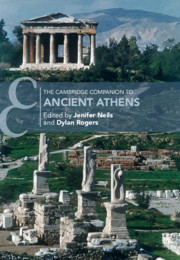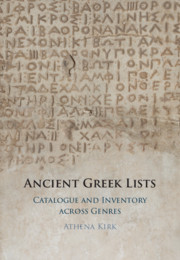Refine search
Actions for selected content:
23990 results in Ancient history
8 - The City, the Goddess and the Festival
-
- Book:
- Serving Athena
- Published online:
- 17 April 2021
- Print publication:
- 11 March 2021, pp 314-335
-
- Chapter
- Export citation
Contents
-
- Book:
- Ancient Greek Lists
- Published online:
- 05 March 2021
- Print publication:
- 11 March 2021, pp vii-vii
-
- Chapter
- Export citation
Abbreviations
-
- Book:
- Ancient Greek Lists
- Published online:
- 05 March 2021
- Print publication:
- 11 March 2021, pp xi-xii
-
- Chapter
- Export citation
Appendix 1 - The Hellenistic Archons of Athens: 323/2 to 48/7 bc
-
- Book:
- Serving Athena
- Published online:
- 17 April 2021
- Print publication:
- 11 March 2021, pp 336-343
-
- Chapter
- Export citation
Chronological Chart of Early Chinese Empires
-
- Book:
- Rumor in the Early Chinese Empires
- Print publication:
- 11 March 2021, pp xiii-xvi
-
- Chapter
- Export citation
Appendix 8 - The Text of Agora XVIII C197
-
- Book:
- Serving Athena
- Published online:
- 17 April 2021
- Print publication:
- 11 March 2021, pp 380-389
-
- Chapter
- Export citation
4 - Chen Prophecies and Prophetic Rhymes
-
- Book:
- Rumor in the Early Chinese Empires
- Print publication:
- 11 March 2021, pp 169-244
-
- Chapter
- Export citation
Introduction to the English Edition
-
-
- Book:
- Rumor in the Early Chinese Empires
- Print publication:
- 11 March 2021, pp 1-7
-
- Chapter
- Export citation
Epilogue
-
- Book:
- Rumor in the Early Chinese Empires
- Print publication:
- 11 March 2021, pp 321-323
-
- Chapter
- Export citation
6 - Creating Identities at the Great Panathenaia: Athenian Men
-
- Book:
- Serving Athena
- Published online:
- 17 April 2021
- Print publication:
- 11 March 2021, pp 212-252
-
- Chapter
- Export citation
1 - Disseminated Talk and Unverifiable Talk
-
- Book:
- Rumor in the Early Chinese Empires
- Print publication:
- 11 March 2021, pp 8-45
-
- Chapter
- Export citation
Appendix 4 - The Pyrrhiche and the Tribal Team Events
-
- Book:
- Serving Athena
- Published online:
- 17 April 2021
- Print publication:
- 11 March 2021, pp 357-360
-
- Chapter
- Export citation
Copyright page
-
- Book:
- Serving Athena
- Published online:
- 17 April 2021
- Print publication:
- 11 March 2021, pp iv-iv
-
- Chapter
- Export citation

The Cambridge Companion to Ancient Athens
-
- Published online:
- 10 March 2021
- Print publication:
- 18 February 2021

Ancient Greek Lists
- Catalogue and Inventory Across Genres
-
- Published online:
- 05 March 2021
- Print publication:
- 11 March 2021

The Origins of the Roman Economy
- From the Iron Age to the Early Republic in a Mediterranean Perspective
-
- Published online:
- 18 February 2021
- Print publication:
- 17 December 2020
33 - Urban Archaeology: Uncovering the Ancient City
- from Reception
-
-
- Book:
- The Cambridge Companion to Ancient Athens
- Published online:
- 10 March 2021
- Print publication:
- 18 February 2021, pp 462-481
-
- Chapter
- Export citation
Part IV - Culture and Sport
-
- Book:
- The Cambridge Companion to Ancient Athens
- Published online:
- 10 March 2021
- Print publication:
- 18 February 2021, pp 293-376
-
- Chapter
- Export citation
Copyright page
-
- Book:
- The Cambridge Companion to Ancient Athens
- Published online:
- 10 March 2021
- Print publication:
- 18 February 2021, pp iv-iv
-
- Chapter
- Export citation
6 - The Agora: Public Life and Administration
- from Part I - The Urban Fabric
-
-
- Book:
- The Cambridge Companion to Ancient Athens
- Published online:
- 10 March 2021
- Print publication:
- 18 February 2021, pp 86-97
-
- Chapter
- Export citation
